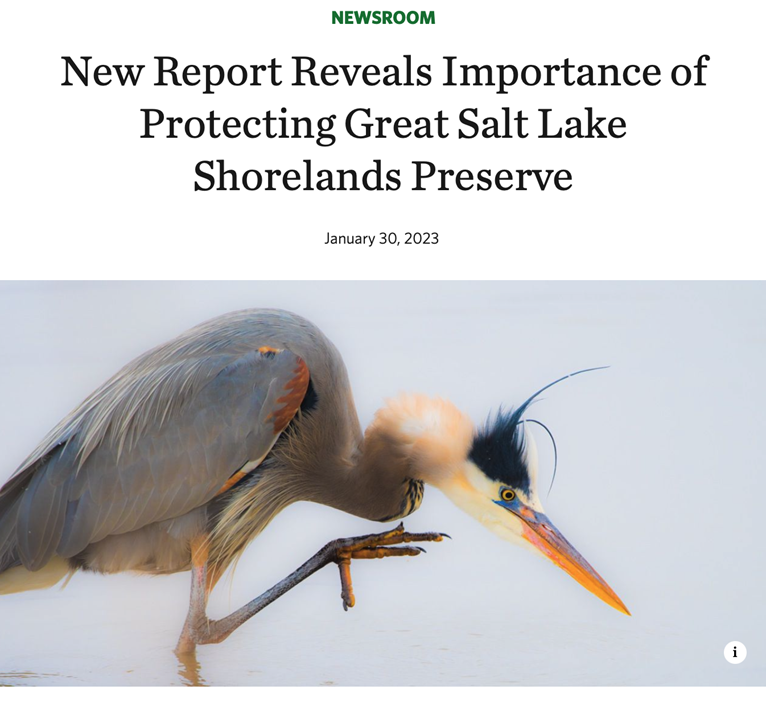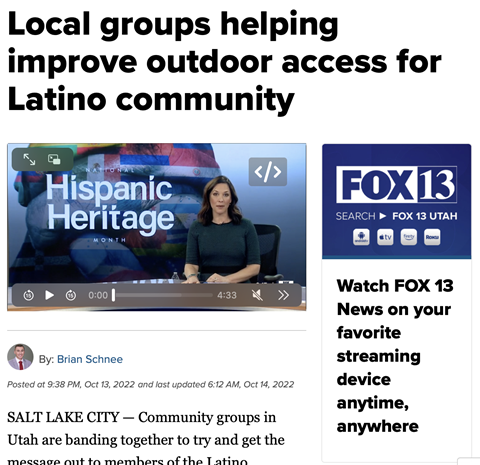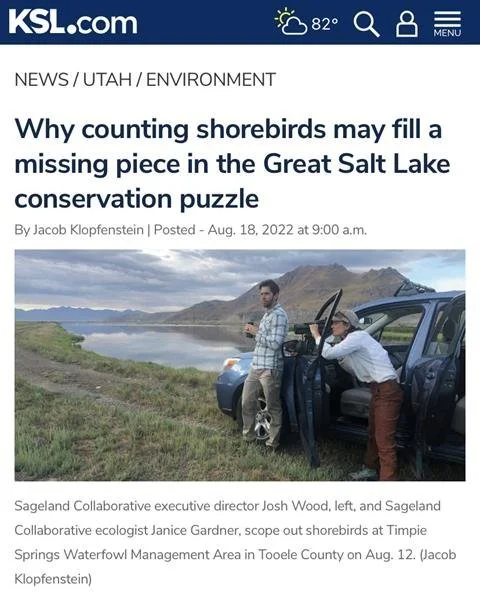“On October 22, 2022, it was another mundane, quarterly gathering of technical experts and brine shrimp harvesters reporting data on Great Salt Lake. Yet, in the middle of the meeting, I found myself — a biologist who has worked with the lake for 15 years — escaping from the conference room to cry in the bathroom.”
Read MoreOur team works passionately on multiple issues tied to Great Salt Lake. From riverscape restoration to our Migratory Shorebird Survey in Utah, our team cares deeply about the lake and communities who depend on it--from shorebirds to humans.
Check out The Nature Conservancy's recent article highlighting the work of Sageland Collaborative staff. Findings include bird activity as potentially linked to the shrinking lake.
Read MoreWe've been talking a lot about beavers, and we're not alone! CBS Mornings shared this story, which features our stream restoration site where we recently released beavers with our partners.
Read MoreA huge thank you to the amazing group of volunteers at our recent Conservación de Castor event.
Thank you as well to our partners at GreenLatinos, Tracy Aviary, Latinos In Action, Arts de Mexico en Utah, Utah Division of Wildlife Resources, and Salt Lake County Parks and Recreation who made this possible. Read the full Fox13 story here.
The health of the shrinking Great Salt Lake is "a matter of life and death for migratory shorebirds," according to Janice Gardner, Sageland ecologist quoted in a recent KSL article. "However, with the lake's water level dropping to historic lows two years in a row," the article continues, "shorebirds are slowly losing critical habitat."
Read MoreAs climate change, drought, and questions about water allocation converge in the West, scientists like stream ecologist Rose Smith work to find meaningful solutions. What kinds of issues can stream restoration help support? Read this recent Fox 13 article to learn what scientists are saying.
Read MoreWe're excited that Utah Public Radio recently hosted Wasatch Wildlife Watch project lead Austin Green. Austin discusses a recent study based on the project, all about how human influence is altering the behavior of several species in northern Utah. Listen to the story here.
Read the paper, published in Conservation Science and Practice, to learn more about effects of human development, environmental factors, and a highway on our Wasatch wildlife. This information is crucial to successful conservation and mindful development. And it's all thanks to our amazing Wasatch Wildlife Volunteers and donors, project leads Austin Green and Mary Pendergast, and our many partners. Thank you!
Read MoreHigh in the snow-covered mountains of Northern Utah, Kim Savides, a graduate student in the Department of Wildland Resources at Utah State University waits for the daily avalanche report during winter months. If favorable, she ventures out to remote bird feeders in hopes of finding black rosy-finches.
The finches thrive in bad weather. When it’s a clear, sunny day Savides knows her likelihood of seeing a finch is slim. But on nasty, snowy, windy days she can count on seeing hundreds of the finches around the feeders…
Read MoreWhat Glen Canyon once was, is slowly starting to come back. At Lake Powell’s high water mark, which hasn’t been under water in over 20 years, dozens of plants, insects and wildlife have been gradually settling back in.
“Because of continued demand for water, for Colorado River water, and climate change as well, we’ve had a two-decade-long shortage on the river system,” Eric Balken, director of the Glen Canyon institute explained. “These canyons that were once filled by the reservoir, they’re now out of water, and there’s a big question as to how those canyons are restoring.”
Read MoreDuring the first half of the show, Nell and Chris learned about the Wasatch Wildlife Watch, a massive citizen science effort using camera traps to gather data about wildlife in the Wasatch Front and how they are impacted by humans. Dr. Mary Pendergast from Wild Utah Project, and Austin Green with the University of Utah joined Chris and Nell to share the details and how listeners can get involved as volunteers.
Read MoreOutdoor recreation and wildlife cohabit in a big way along the Central Wasatch Mountains and the foothills that tumble into Utah’s largest urban area, yet scientists have only a vague idea of how animals respond to all the athletes, picnickers and hikers traipsing through their living room.
Now biologist Austin Green hopes to find firm answers using dozens of trap cameras. But his research has generated more information than he and his team can handle: 50,000 critter images recorded during a 105-day study period last spring and summer.
Read MoreThere has perhaps not been a more important time to hone our understanding of the current state of ecological health and function of the Wasatch Mountains and the wildlife that live here.
The Wasatch sustains 9 million visitors a year, which is about the same as that of the “mighty five” Utah national parks. Currently many planning processes and opportunities to shape the future of the central Wasatch are unfolding, ranging from the Central Wasatch National Conservation and Recreation Area legislation, transportation solutions from the recent blue print of the Central Wasatch Mountain Accord, and other national forest planning opportunities.
Read MoreFederal officials are proposing to substantially expand hunting in Utah’s Bear River Migratory Bird Refuge as part of a wider effort to boost hunter access to the nation’s wildlife preserves and other public lands.
Some conservation groups are skeptical of the plan, outlined in a draft environmental assessment released last week by the U.S. Fish and Wildlife Service.
Read MoreAlthough studies by various wildlife organizations have reported the greater sage grouse population has been in decline for the past 50 years, the U.S. Fish and Wildlife Service concluded in 2015 that the birds were warranted for protection under the U.S. Federal Endangered Species Act.
Read MoreIn his recent article, “The facts about multiple land use in Utah” (Nov. 26), Don Peay argues that national parks and monuments are, on balance, bad for wildlife and unfair to hunters. Thus, he welcomed President Trump to Utah to announce the shrinking of Bears Ears and Grand Staircase-Escalante national monuments. Let’s take a look at Peay’s alleged facts.
Read MoreLeaders in Western states pressed their case in a congressional hearing Wednesday that management of the greater sage grouse is best carried out without federal interference.
"Federal land management agencies have made threats to the sage grouse worse," said Idaho Speaker of the House Scott Bedke, R-Twin Falls.
Bedke testified before the U.S. House Committee on Natural Resources, chaired by Rep. Rob Bishop, R-Utah, during an oversight hearing on "state-based management solutions" to protect and restore the birds' number.
Read MoreConservationists complain the state is sacrificing alpine landscapes just to provide more opportunities for big game hunting. The La Sals are already showing signs where wallowing goats have exposed soils and left excrement and hair all around, according to researchers.
Read MoreThe Bureau of Land Management’s attempt on Tuesday to auction nine parcels in Utah’s West Desert for oil and gas development was a bust, with just three parcels attracting the minimum bid of $2 an acre, netting the federal agency a grand total of $14,837.
The auction, which targeted nearly 15,000 acres west of Nephi, was controversial because the lands are home to Utah’s most imperiled population of greater sage grouse. Four of the parcels overlapped “priority habitat management areas” outlined under the BLM’s sage grouse land-use plans, now under review by the Trump administration.
ST. GEORGE — The Utah Wildlife Board voted Thursday to allow an additional 50 hunting permits for cougars to be issued in the upcoming 2017-18 hunting season.
The motion to increase the number of permits from 531 to 581, several of which include areas in Southern Utah, was approved unanimously in a public meeting in Salt Lake City by the board, which is composed of seven citizens appointed by the governor.
Read MoreDivision staff will present their recommendations to the state wildlife board on Aug. 31. They’re suggesting 579 cougar hunting permits for the year, compared to 531 last year. The reason for the increase, state biologists say, is because cougar populations continue to grow. Wildlife advocates, however, say the state’s methods are flawed.
“We think since about 2004, (cougar populations) have probably been growing by about 3 percent per year,” said Darren DeBloois, game mammals program coordinator for DWR.
There are no firm estimates on how many mountain lions live in Utah, since the animals are elusive and hard to track. DWR models suggest numbers between 1,900 and 4,000 adult animals. Authorizing hunters to potentially take 14 percent to 30 percent of the cougar population is unconscionable, conservationists say.
“This is concerning to us as scientists,” said Allison Jones with the Wild Utah Project. “It’s concerning to wildlife lovers, cougar lovers and environmental activists.”
Read More



















